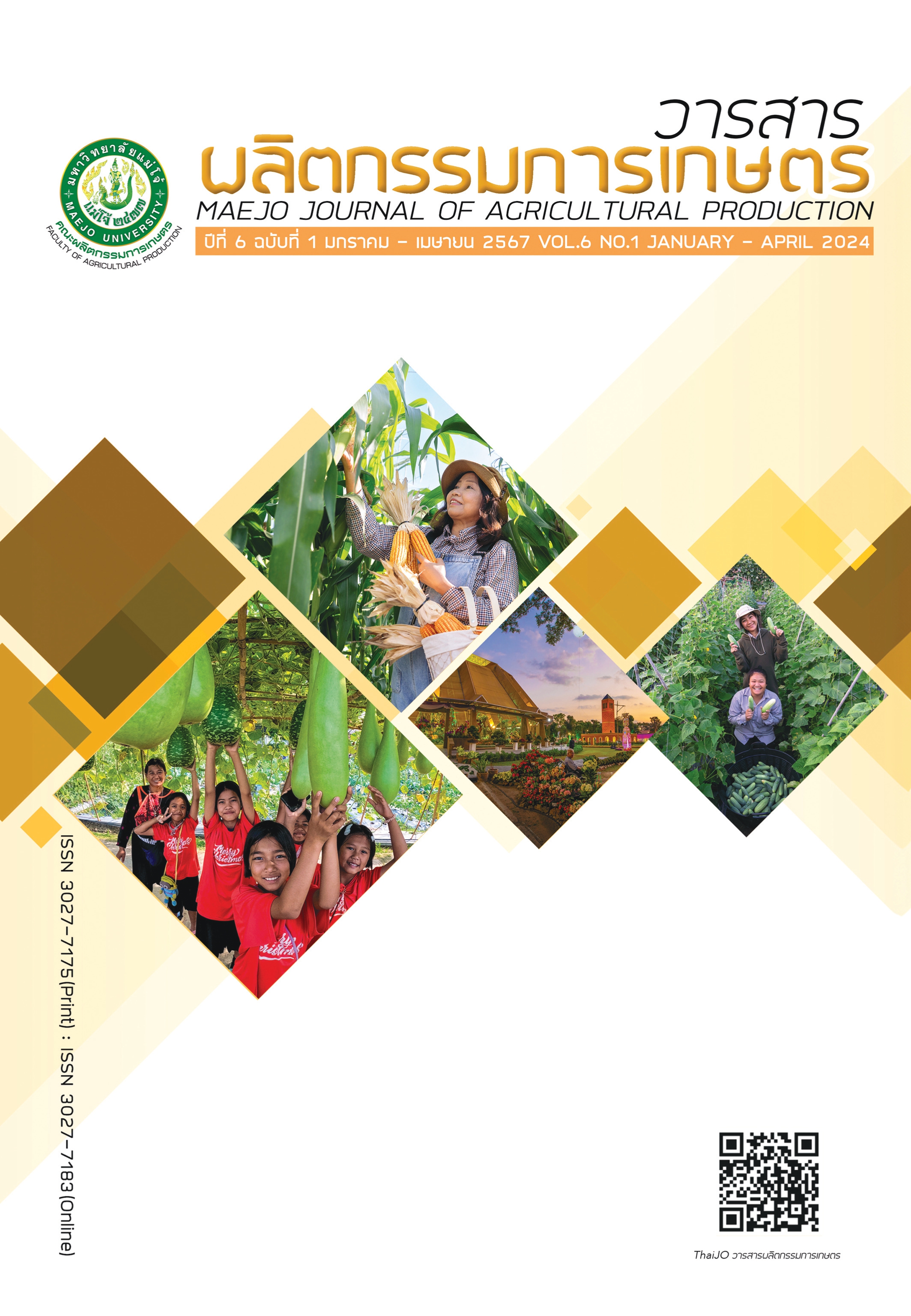ผลทางอัลลีโลพาธีของสารสกัดปืนนกไส้ (Bidens pilosa L.) ต่อการงอกและการเจริญของต้นอ่อนข้าววัชพืช (Oryza sativa f. spontanea Roshev.) และไมยราบเลื้อย (Mimosa diplotricha C.Wright ex Sauvalle)
Main Article Content
บทคัดย่อ
การศึกษาครั้งนี้ได้นำ ปืนนกไส้ (Bidens pilosa L.) วัชพืชในวงศ์ Asteraceae มาศึกษาผลต่อการงอกและการเจริญของต้นอ่อนข้าววัชพืช (Oryza sativa f.spontanea Roshev.) และไมยราบเลื้อย (Mimosa diplotricha C.Wright ex Sauvalle) โดยสกัดด้วยตัวทำละลาย 2 ชนิด ได้แก่ เอทานอล 80% และไดคลอโรมีเทน ใช้สารสกัด 4 ความเข้มข้น (5, 10, 25 และ 50 mg mL-1) ทดสอบกับเมล็ดวัชพืชทดสอบทั้ง 2 ชนิด โดยวางแผนการทดลองแบบสุ่มสมบูรณ์ (Completely randomized design; CRD) และทำการทดลองทั้งหมด 4 ซ้ำ แต่ละซ้ำใช้เมล็ดพืชทดสอบ 25 เมล็ด สังเกตการเปลี่ยนแปลงของเมล็ดเป็นเวลา 1 สัปดาห์ นับจำนวนเมล็ดที่งอก
วัดความยาวลำต้นและราก คำนวณดัชนีความแข็งแรงของต้นกล้าเปอร์เซ็นต์การงอก และเปอร์เซ็นต์การยับยั้งความยาวลำต้นและราก
จากการทดลองพบว่า สารสกัดเอทานอล 80% ความเข้มข้น 50 mg mL-1 สามารถยับยั้งการงอกและการเจริญของต้นอ่อนข้าววัชพืชได้ดีที่สุด คิดเป็นเปอร์เซ็นต์การยับ ยั้งความยาวลำต้นและรากเท่ากับ 66.39% และ 85.96% ตามลำดับ แต่เมื่อทดสอบกับไมยราบเลื้อยพบว่า สารสกัดไดคลอโรมีเทน 50 mg mL-1 สามารถยับยั้งการงอกและการเจริญของต้นอ่อนไมยราบเลื้อยได้ดีที่สุดคิดเป็นเปอร์เซ็นต์การยับยั้งความยาวลำต้นและรากเท่ากับ 95.14% และ 83.80% ตามลำดับ แสดงให้เห็นว่า สารอัลลีโลเคมิคอลในปืนนกไส้ที่ยับยั้งการงอกและการเจริญของข้าววัชพืชและไมยราบเลื้อยอาจเป็นสารคนละกลุ่ม ซึ่งผลการทดลองที่ได้สามารถนำไปเป็นแนวทางในการพัฒนาวิธีการสกัดสารออกฤทธิ์ทางอัลลีโลพาธีจากปืนนกไส้ เพื่อใช้ทดแทนสารเคมีกำจัดวัชพืชในอนาคต
Article Details

อนุญาตภายใต้เงื่อนไข Creative Commons Attribution-NonCommercial-NoDerivatives 4.0 International License.
เอกสารอ้างอิง
ดวงพร สุวรรณกุล และรังสิต สุวรรณเขตนิคม. 2544. วัชพืชในประเทศไทย. มหาวิทยาลัยเกษตรศาสตร์, กรุงเทพฯ.
รัตนา อินทรานุปกรณ์. 2550. การตรวจสอบและการสกัดแยกสารสำคัญจากสมุนไพร. จุฬาลงกรณ์มหาวิทยาลัย, กรุงเทพฯ.
Beckie, H.J., and F.J. Tardif. 2012. Herbicide cross resistance in weeds. Crop Protection 35: 15-28.
Campbell, G., J.D.H. Lambert, T. Arnason and G.H.N. Towers. 1982. Allelopathic properties of α-terthienyl and phenylheptatriyne, naturally occurring compounds from species of asteraceae. Journal of Chemical Ecolog 8(6): 961-972.
Deba, F., T.D. Xuan, M. Yasuda and S. Tawata. 2007. Herbicidal and fungicidal activities and identification of potential phytotoxins from Bidens pilosa L. var. radiata Scherff. Weed Biology And Management 7(2): 77-83.
Einhellig, F.A. 1995. Mechanism of action of allelochemicals in allelopathy. pp. 96-116. In: Inderjit, K.M.M. Dakshini, and F.A. Einhellig (eds.) Allelopathy, Organisms, Processes and Applications. ACS Publications. Washington DC, USA.
Grombone-Guaratini, M.T., K.L. Silva-Brandao, V.N. Solferini, J. Semir and J.R. Trigo. 2005. Sesquiterpene and polyacetylene profile of the Bidens pilosa complex (Asteraceae: Heliantheae) from Southeast of Brazil. Biochemical Systematics and Ecology 33(5): 479-486.
Hong, N.H., T.D. Xuan, T. Eiji and T.D. Khanh. 2004. Paddy weed control by higher plants from Southeast Asia. Crop Protection 23(3): 255- 261.
Hsueh, M.-T., C. Fan and W.L. Chang. 2020. Allelopathic effects of Bidens pilosa L. var. radiata Sch. Bip. on the tuber sprouting and seedling growth of Cyperus rotundus L. Plants 9(6): 742.
Jabran, K., G. Mahajan, V. Sardana and B.S. Chauhan. 2015. Allelopathy for weed control in agricultural systems. Crop Protection 72: 57-65.
Khanh, T., L. Cong, T. Xuan, Y. Uezato, F. Deba, T. Toyama and S. Tawata. 2009. Allelopathic plants: 20. Hairy beggarticks (Bidens pilosa L.) International Allelopathy Foundationl 24(1): 243-259.
Müller, J., and A. Heindl. 2006. Drying of medicinal plants. Frontis 17: 237-252.
Oerke, E. 2005. Crop losses to pests. The Journal of Agricultural Science 144(1): 31-43.
Poonpaiboonpipat, T., U. Pangnakorn, U. Suvunnamek, M. Teerarak, P. Charoenying and C. Laosinwattana. 2013. Phytotoxic effects of essential oil from Cymbopogon citratus and its physiological mechanisms on barnyardgrass (Echinochloa crus-galli). Industrial Crops and Products 41: 403-407.
Poonpaiboonpipattana, T. 2015. Allelopathic effects of Bidens pilosa var. radiata and its preliminary utilization to control weeds in rice. International Journal of Agricultural Technology 11(8): 1875-1886.
Westwood, J.H., R. Charudattan, S.O. Duke, S.A. Fennimore, P. Marrone, D.C. Slaughter, C. Swanton and R. Zollinger. 2018. Weed management in 2050: perspectives on the future of weed science. Weed Science 66(3): 275-285.


